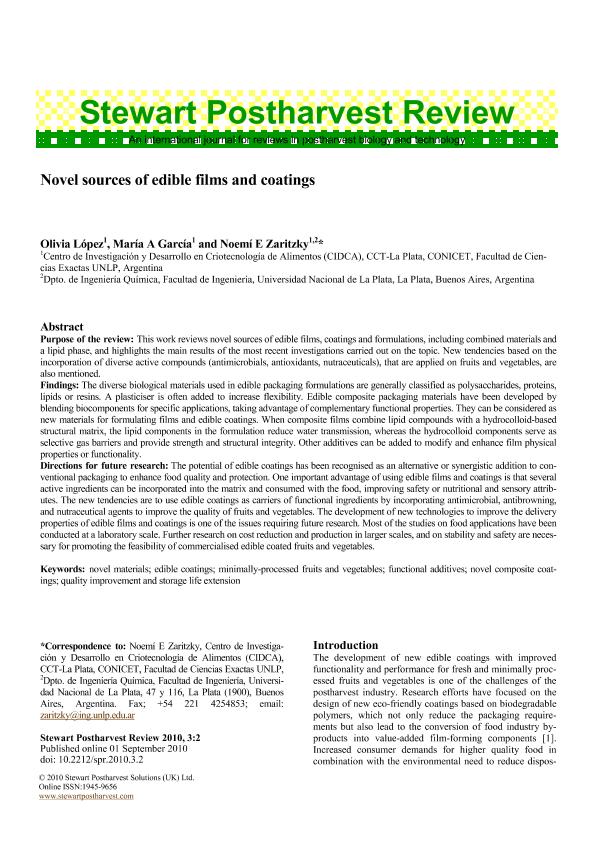Mostrar el registro sencillo del ítem
dc.contributor.author
Lopez, Olivia Valeria

dc.contributor.author
Garcia, Maria Alejandra

dc.contributor.author
Zaritzky, Noemi Elisabet

dc.date.available
2018-08-30T15:39:20Z
dc.date.issued
2010-09
dc.identifier.citation
Lopez, Olivia Valeria; Garcia, Maria Alejandra; Zaritzky, Noemi Elisabet; Novel sources of edible films and coatings; Stewart Postharvest Solutions; Stewart Postharvest Review; 6; 3; 9-2010; 1-8
dc.identifier.issn
1745-9656
dc.identifier.uri
http://hdl.handle.net/11336/57687
dc.description.abstract
Purpose of the review: This work reviews novel sources of edible films, coatings and formulations, including combined materials and a lipid phase, and highlights the main results of the most recent investigations carried out on the topic. New tendencies based on the incorporation of diverse active compounds (antimicrobials, antioxidants, nutraceuticals), that are applied on fruits and vegetables, are also mentioned. Findings: The diverse biological materials used in edible packaging formulations are generally classified as polysaccharides, proteins, lipids or resins. A plasticiser is often added to increase flexibility. Edible composite packaging materials have been developed by blending biocomponents for specific applications, taking advantage of complementary functional properties. They can be considered as new materials for formulating films and edible coatings. When composite films combine lipid compounds with a hydrocolloid-based structural matrix, the lipid components in the formulation reduce water transmission, whereas the hydrocolloid components serve as selective gas barriers and provide strength and structural integrity. Other additives can be added to modify and enhance film physical properties or functionality. Directions for future research: The potential of edible coatings has been recognised as an alternative or synergistic addition to conventional packaging to enhance food quality and protection. One important advantage of using edible films and coatings is that several active ingredients can be incorporated into the matrix and consumed with the food, improving safety or nutritional and sensory attributes. The new tendencies are to use edible coatings as carriers of functional ingredients by incorporating antimicrobial, antibrowning, and nutraceutical agents to improve the quality of fruits and vegetables. The development of new technologies to improve the delivery properties of edible films and coatings is one of the issues requiring future research. Most of the studies on food applications have been conducted at a laboratory scale. Further research on cost reduction and production in larger scales, and on stability and safety are necessary for promoting the feasibility of commercialised edible coated fruits and vegetables.
dc.format
application/pdf
dc.language.iso
eng
dc.publisher
Stewart Postharvest Solutions
dc.rights
info:eu-repo/semantics/openAccess
dc.rights.uri
https://creativecommons.org/licenses/by-nc-sa/2.5/ar/
dc.subject
Edible Coatings
dc.subject
Functional Additives
dc.subject
Minimally-Processed Fruits And Vegetables
dc.subject
Novel Composite Coatings
dc.subject
Novel Materials
dc.subject
Quality Improvement And Storage Life Extension
dc.subject.classification
Alimentos y Bebidas

dc.subject.classification
Otras Ingenierías y Tecnologías

dc.subject.classification
INGENIERÍAS Y TECNOLOGÍAS

dc.title
Novel sources of edible films and coatings
dc.type
info:eu-repo/semantics/article
dc.type
info:ar-repo/semantics/artículo
dc.type
info:eu-repo/semantics/publishedVersion
dc.date.updated
2018-07-11T14:01:22Z
dc.journal.volume
6
dc.journal.number
3
dc.journal.pagination
1-8
dc.journal.pais
Reino Unido

dc.journal.ciudad
Londres
dc.description.fil
Fil: Lopez, Olivia Valeria. Provincia de Buenos Aires. Gobernación. Comisión de Investigaciones Científicas. Centro de Investigación y Desarrollo en Criotecnología de Alimentos. Consejo Nacional de Investigaciones Científicas y Técnicas. Centro Científico Tecnológico Conicet - La Plata. Centro de Investigación y Desarrollo en Criotecnología de Alimentos. Universidad Nacional de La Plata. Facultad de Ciencias Exactas. Centro de Investigación y Desarrollo en Criotecnología de Alimentos; Argentina
dc.description.fil
Fil: Garcia, Maria Alejandra. Provincia de Buenos Aires. Gobernación. Comisión de Investigaciones Científicas. Centro de Investigación y Desarrollo en Criotecnología de Alimentos. Consejo Nacional de Investigaciones Científicas y Técnicas. Centro Científico Tecnológico Conicet - La Plata. Centro de Investigación y Desarrollo en Criotecnología de Alimentos. Universidad Nacional de La Plata. Facultad de Ciencias Exactas. Centro de Investigación y Desarrollo en Criotecnología de Alimentos; Argentina
dc.description.fil
Fil: Zaritzky, Noemi Elisabet. Provincia de Buenos Aires. Gobernación. Comisión de Investigaciones Científicas. Centro de Investigación y Desarrollo en Criotecnología de Alimentos. Consejo Nacional de Investigaciones Científicas y Técnicas. Centro Científico Tecnológico Conicet - La Plata. Centro de Investigación y Desarrollo en Criotecnología de Alimentos. Universidad Nacional de La Plata. Facultad de Ciencias Exactas. Centro de Investigación y Desarrollo en Criotecnología de Alimentos; Argentina
dc.journal.title
Stewart Postharvest Review
dc.relation.alternativeid
info:eu-repo/semantics/altIdentifier/doi/https://dx.doi.org/10.2212/spr.2010.3.2
dc.relation.alternativeid
info:eu-repo/semantics/altIdentifier/url/http://access.portico.org/Portico/#!journalAUSimpleView/tab=PDF?cs=ISSN_17459656?ct=E-Journal%20Content?auId=ark:/27927/phx64r6c9q7
Archivos asociados
